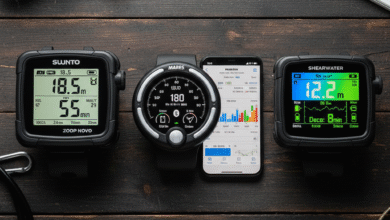The Ocean’s Elite: The Best Liveaboard Dive Trips for Advanced Divers
For the seasoned diver, the call of the deep is a different beast—it’s the whisper of strong currents, the promise of massive pelagics, and the challenge of remote, untouched corners of the ocean. Forget crowded beginner reefs; the advanced diver seeks the heart-pounding action only accessible by a dedicated liveaboard.
If you’ve got your Advanced Open Water certification, a healthy logbook (50+ dives is often the recommended minimum), and a desire for truly world-class diving, pack your bags and your reef hook. We’ve surfaced the top three liveaboard destinations for divers who consider “challenging” a compliment.
1. The Galapagos Islands, Ecuador: The Ultimate Big Animal Mecca
The Galapagos is not a dive for the faint of heart, and it’s certainly not for beginners. These volcanic islands, forged by Darwin’s theory, are where the world’s major ocean currents collide, resulting in an explosion of marine life and some seriously strong drift dives.
- Why Advanced Divers Go: The real action is exclusively accessible by liveaboard at the remote Wolf and Darwin Islands. Here, divers often use reef hooks to hold onto the volcanic rock while massive schools of scalloped hammerhead sharks and giant whale sharks swim past in the currents. Encounters with playful sea lions, marine iguanas, and the endemic Galapagos shark are daily occurrences.
- The Challenge: Currents range from moderate to ripping, and water temperatures can fluctuate rapidly due to thermoclines, often requiring a 7mm wetsuit or even a dry suit. You need excellent buoyancy and comfort diving in surge.
- Need-to-Know:
- Mandatory Requirements: Most liveaboards require an Advanced Open Water certification (or Open Water with a Deep Diver Specialty) and a minimum of 50 logged dives.
- Safety Gear: All dives are guided, and a dive computer, surface marker buoy (SMB), and often a Nautilus GPS/locator beacon are mandatory.
- Highlight Dives: Wolf and Darwin Islands, which promise the world’s most reliable large animal action.
2. Palau, Micronesia: Drift Dives, Reef Hooks, and WWII History
Palau is a legendary destination where three major ocean currents converge, creating some of the most current-fueled action on the planet. This Pacific paradise perfectly blends breathtaking natural walls with fascinating wartime history.
- Why Advanced Divers Go: Palau is the home of the famous Blue Corner, an oceanic intersection where powerful currents draw in hundreds of grey reef sharks, eagle rays, and schooling pelagics. Drift diving is the name of the game, often using a reef hook to secure yourself to the reef edge to watch the spectacle unfold.
- The Challenge: Strong, unpredictable currents are a core feature of the best sites. The diving is fast-paced, and you must be comfortable with negative entries and precise current management.
- Need-to-Know:
- Certification: Advanced Open Water and comfort with drift diving are highly recommended. Nitrox is a huge advantage for maximizing bottom time.
- Top Dive Sites:
- Blue Corner: The legendary shark and pelagic viewing platform.
- German Channel: A strong-current cleaning station famous for guaranteed Manta Ray encounters.
- WWII Wrecks: Explore history on sites like the Iro Maru, a massive freighter now serving as an artificial reef.
- Unique Experience: While not a dive, all itineraries include a visit to Jellyfish Lake, where you can snorkel with millions of stingless jellyfish.
3. Maldives Deep South: Channel Diving for Shark Thrills
While the “Best of Maldives” itineraries are fantastic for all levels, the remote Deep South routes are specifically designed for the adrenaline-seeking advanced diver, transforming this luxury destination into a pelagic hunting ground.
- Why Advanced Divers Go: The Southern Atolls (Huvadhoo, Fuvahmulah, Addu) are characterized by deep, narrow channels that funnel nutrient-rich water and massive schools of fish—and the predators that follow them. The goal here is channel diving and guaranteed shark action.
- The Challenge: The diving is almost exclusively drift diving through channels with medium-to-strong currents. Good air consumption and a mastery of drift diving techniques are necessary to position yourself correctly in the current and maximize shark sightings.
- Need-to-Know:
- Recommended Experience: Routes like “Southern Shark Adventure” or “Deep South” are often marked as “Not suitable for beginners” and recommend 50+ logged dives.
- Shark Highlights:
- Fuvahmulah Atoll: Famous for being one of the only places in the world with reliable sightings of Tiger Sharks and Thresher Sharks.
- Huvadhoo Atoll: Incredible grey reef shark and oceanic whitetip shark action in the channels.
- The Experience: You’ll typically dive from a dhoni (tender boat) to ensure precise entry and exit points in the current.
What to Look for in an Advanced Liveaboard
- Certification Requirements: Always check the minimum certification and logged dives required by the operator.
- Safety Gear: Reputable liveaboards for advanced diving in remote locations will provide or require safety equipment like Nautilus GPS, DiveAlert, and SMBs.
- Nitrox: For repetitive deep dives, Nitrox becomes essential. Look for liveaboards that offer free or affordable Nitrox packages.
- Experience: Choose itineraries explicitly labeled as challenging, deep, or pelagic-focused, as these will take you away from the shallower, beginner-friendly sites.
Ready to graduate from the reef to the deep? Your next great dive adventure awaits.



